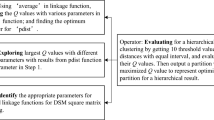Abstract
Product architecture represents components grouped into modules that can be assembled later to constitute a specific variant. Literature provides Methods of clustering components into weakly related modules with strong interconnections between components within modules. The number of modules and their hierarchical relationships shape product architecture and determine the balance between modular design and components integration. A novel hierarchical clustering approach, based on the biological Cladistics analysis, has been developed to cluster Design Structure Matrix (DSM) widely used to promote modularity. It evaluates different granularity levels of the resulting hierarchy and finds the best granularity level for maximum modularity. An automotive Body-in-White of 38 different components is used as a case study. Results showed the superiority of the recommended modularity pattern and synthesized product architecture over other clustering techniques.
Access this chapter
Tax calculation will be finalised at checkout
Purchases are for personal use only
Preview
Unable to display preview. Download preview PDF.
Similar content being viewed by others
References
Ulrich, K.T., Eppinger, S.D.: Product design and development, 5th edn. McGraw-Hill Irwin, Boston (2012)
ElMaraghy, H.: Changing and Evolving Products and Systems - Models and Enablers. In: ElMaraghy, H. (ed.) Changeable and Reconfigurable Manufacturing Systems, ch. 2, pp. 25–45. Springer, London (2009)
Xuehong, D., Jianxin, J., Tseng, M.M.: Architecture of product family: fundamentals and methodology. Concurrent Engineering: Research and Applications 9(Copyright 2002, IEE), 309–325 (2001)
AlGeddawy, T., ElMaraghy, H.: Product Variety Management in Design and Manufac-turing: Challenges and Strategies. In: Proceeding of the 4th International Conference on Changeable, Agile, Reconfigurable and Virtual Production (CARV 2011), Montreal, Canada (2011)
Eppinger, S.D., Browning, T.R.: Design structure matrix methods and applications. In: Engineering Systems 2012, xii, 334 p. MIT Press, Cambridge (2012)
Thebeau, R.E.: Knowledge Management of System Interfaces and Interactions for Product development Processes. In: System Design and Management 2001. Massachusetts Institute of Technology (2001)
Tian-Li, Y., Yassine, A.A., Goldberg, D.E.: An information theoretic method for de-veloping modular architectures using genetic algorithms. Research in Engineering Design 18(2), 91–109 (2007)
Pandremenos, J., Chryssolouris, G.: A neural network approach for the development of modular product architectures. International Journal of Computer Integrated Manufacturing 24(10), 879–887 (2011)
Sharman, D.M., Yassine, A.A.: Characterizing complex product architectures. Systems Engineering 7(1), 35–59 (2004)
Chiriac, N., Holtta-Otto, K., Lysy, D., Eun Suk, S.: Level of Modularity and Different Levels of System Granularity. Journal of Mechanical Design 133(10), 101007 (2011)
Hennig, W.: Phylogenitic Systematics. University of Illinois Press, Urbana (1966); republished in 1999
ElMaraghy, H., AlGeddawy, T., Azab, A.: Modelling evolution in manufacturing: A biological analogy. CIRP Annals - Manufacturing Technology 57(1), 467–472 (2008)
Nixon, K.C.: The Parsimony Ratchet, a New Method for Rapid for Rapid Parsimony Analysis. Cladistics 15(1), 407–414 (1999)
Pandremenos, J., Chatzikomis, C., Chryssolouris, G.: On the Quantification of Interface Design Architectures. AIJSTPME 2(3), 41–48 (2009)
Millet, D., Yvars, P.-A., Tonnelier, P.: A method for identifying the worst recycling case: Application on a range of vehicles in the automotive sector. Resources, Conservation and Recycling 68(0), 1–13 (2012)
Author information
Authors and Affiliations
Corresponding author
Editor information
Editors and Affiliations
Rights and permissions
Copyright information
© 2013 Springer-Verlag Berlin Heidelberg
About this paper
Cite this paper
AlGeddawy, T., ElMaraghy, H. (2013). Determining Granularity Level in Product Design Architecture. In: Abramovici, M., Stark, R. (eds) Smart Product Engineering. Lecture Notes in Production Engineering. Springer, Berlin, Heidelberg. https://doi.org/10.1007/978-3-642-30817-8_52
Download citation
DOI: https://doi.org/10.1007/978-3-642-30817-8_52
Publisher Name: Springer, Berlin, Heidelberg
Print ISBN: 978-3-642-30816-1
Online ISBN: 978-3-642-30817-8
eBook Packages: EngineeringEngineering (R0)




